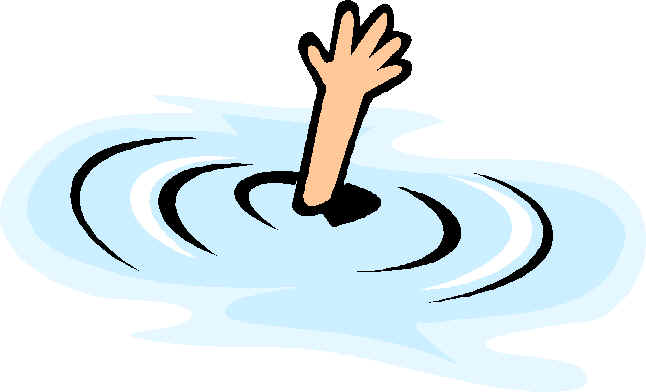Drowning
Drowning occurs after experiencing respiratory impairment from submersion/immersion in liquid which causes a lack of oxygen for the casualty. Drowning is a common cause of accidental death.
The most important consideration the first aid provider can make is to ensure safety. Do not attempt a rescue beyond your capabilities.
Immediate resuscitation at the scene is essential for survival of the casualty after drowning. This requires immediate CPR and calling Triple Zero (000) for an ambulance.
Whenever possible, attempt to save the drowning casualty without entry into the water. If entry into the water is essential, take a buoyant rescue aid or flotation device.
Remove all drowning casualties from water by the fastest and safest means available and begin resuscitation as quickly as possible. Use a rescue aid, rope or buoyant aid if the casualty is close to dry land. Use a boat or other water vehicle if possible.
 Signs and symptoms
Signs and symptoms
- Pale, cool skin
- Absent, rapid or laboured respirations
- Decreased level of consciousness
- Coughing
- Cyanosis (bluish colour)
- No signs of life
Untrained rescuers should not attempt to perform any form of resuscitation with a casualty in deep water.
- Care and treatment:
- Call Triple Zero (000) for an ambulance
- Check airway and breathing
- If safe to do so, give rescue breaths while rescuing from the water
- Commence immediate CPR if required
- Place in recovery position once breathing is restored
- Treat hypothermia if present
- Suspect and treat spinal injuries
Drowning has a detrimental effect on the respiratory system and recovery, since the casualty may experience a build-up of fluid in the lungs. All casualties' that have had a drowning experience should seek immediate medical attention.
Do not attempt a rescue beyond your capabilities
Diving emergencies
The majority of diving accidents involve recreational divers using self-contained underwater breathing apparatus (SCUBA).
Observance for safety takes precedence over all first aid activities and casualties or potential casualties should always be removed from the water prior to first aid assessment and treatment.
Decompression sickness commonly called 'the bends', decompression sickness is caused by the formation of bubbles of gas (nitrogen) in the joints, circulatory system and tissues of the body. The bubbles formed usually block the small blood vessels and cause an embolism. Onset is usually within two hours, but may appear after many hours
Signs and symptoms:
Some or all of the following:
- Joint pain
- Dizziness
- Staggering gait
- Loss of balance
- Shortness of breath
- Dizziness
- Itching of the skin
- Partial paralysis
- Headache
- Coughing
- Pins and needles
Care and treatment:
- Seek medical assistance immediately (24 Hour Diver Emergency Service (DES) on 1800 088 200)
- Encourage the diver to remain calm and still
- Reassurance
- If unconscious, place the casualty in the recovery position
- If conscious, place the casualty flat
- If severe breathing difficulties present, you may need to sit the casualty upright
- Administer 100% or high concentration oxygen if available
- Protect against hypothermia
- Discourage attempts by others to take the diver back underwater to the original depth in a futile attempt at re-compression
- Never administer Entonox (gas and air), as this will worsen the condition due to its high nitrogen content
Electric shock
The human body is an efficient conductor of electricity. When a casualty receives an electric shock from a household appliance or a power line, the electricity is conducted through the body.
A casualty may receive significant burns or the electric shock may interfere with the heart's electrical system. Burns to the casualty may be internal and greater than they appear on the surface.
Domestic voltage
It is urgent the casualty be disconnected from the electrical source by either:
- Turning off the power supply and disconnecting any plugs from the outlet and isolating the electricity supply at the main power board if possible
- Removing the casualty from the electrical source by pushing or pulling them with non-conducting materials, e.g., wooden stick/ board, rope, curtains or blanket
Be careful not to touch the casualty's skin before the electrical source is disconnected and be alert for the presence of water or conducting materials with which they may be in contact.
High voltage
High voltage electrocution involves an extreme degree of risk to rescuers. If the electrical source is part of the electrical distribution grid (poles, pylons, underground cables, transformers or stations) you must not enter the area until electrical authorities have certified it safe.
You can do nothing for a casualty within the zone of danger! Protect yourself and others
Sign and symptoms:
- Difficult or absent breathing
- Absent, weak or irregular pulse
- Evidence of burns
- Evidence of fractures
- Entrance and exit wound burns
- Collapse and unconsciousness
Care and treatment:
- Call Triple Zero (000) for an ambulance
- Inform electrical authorities if high voltage involved
- If no signs of life - commence rescue breathing and compressions
- Cool and cover burns with non-stick dressings
- Reassurance